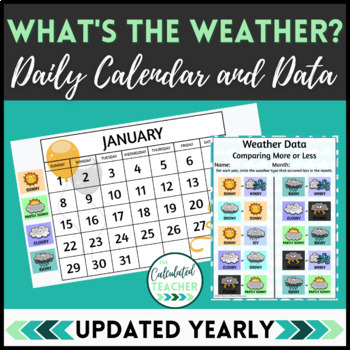Daily Weather Chart Digital Calendar Tracking and Data Analysis 2023
- Google Drive™ folder

What educators are saying
Description
These digital calendars will give your students an opportunity to track the weather every day and practice using the data! This is a simple drag and drop resource that can be used in many ways including morning meeting, math and science practice, and life skills practice. Students will practice counting and comparing more and less.
Updated for 2023!
Included in a Google Folder:
- Calendars for 2023
- Each calendar has movable pieces for the following weather: sunny, partly sunny, cloudy, rainy, windy, stormy, snowy, and icy
- 3 data sheets-digital and printable
Use For:
- whole group activity
- individual activity
What Others Are Saying:
⭐⭐⭐⭐⭐ Tawni says "Exactly what I needed! We use a very scripted math program. However, I wanted to add weather to my instruction as well. My classroom is in a modular so wall space is nonexistence. So, having a weather tracker digitally was PERFECT!"
⭐⭐⭐⭐⭐ Leah says "Perfectly aligned with weather and graphing!"
⭐⭐⭐⭐⭐ Michelle says "I have been doing weather conditions during my data unit and this was so helpful to use in a hybrid learning situation each morning. Loved the colorful calendar and icons. The questions to use to gather info after the month was such good review for the students also."
Related Products:
- Telling Time to the Minute I Have, Who Has
- Identifying Numbers on a Number Line
- Identifying Fractions I Have, Who Has
Customer Tips:
How to get TPT credit to use on future purchases:
- Go to your My Purchases page (you may need to log in).
- Beside each purchase, you'll see a Provide Feedback button. Simply click it and you will be taken to a page where you can give a quick rating and leave a short comment for the product. *Each time you give feedback, TPT gives you credits that you use to lower the cost of your future purchases. I value your feedback greatly as it helps me determine which products are most valuable for your classroom so I can create more for you.
Be the first to know about my new discounts, freebie,s and product launches:
★ Click here to become a follower and receive updates.
Check out my blog for resources and teaching ideas.
Please reach out in the Q&As if you have a question or concern with this product.
Copyright © The Calculated Teacher.
Permission to copy for single classroom use.
Please purchase additional licenses if you want to share this product.





